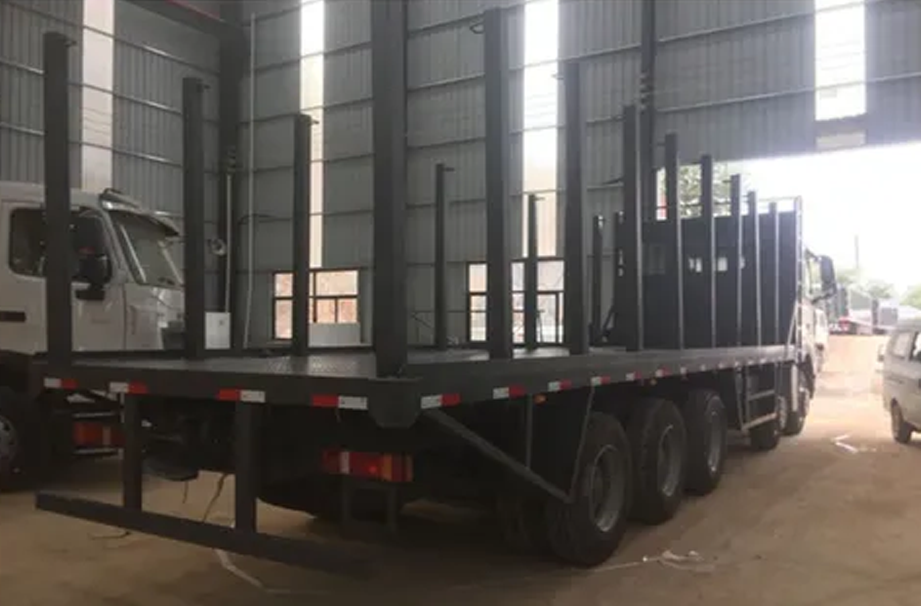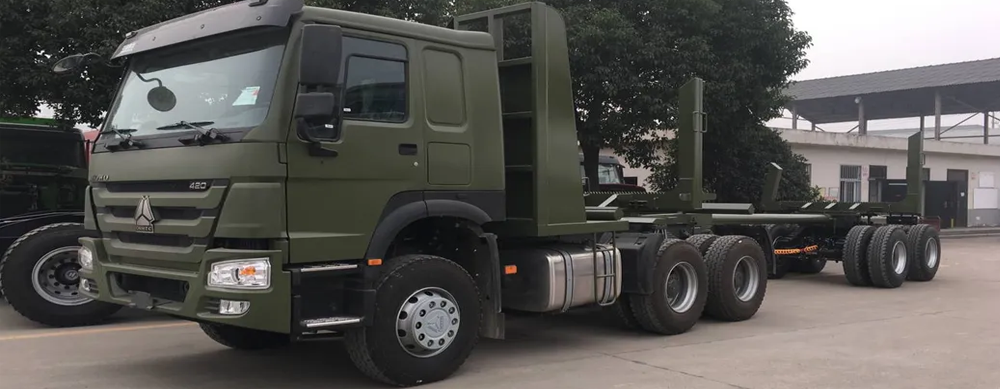Logging Trucks are specialized vehicles designed for the efficient transportation of timber. They possess a heavy-duty truck chassis, typically constructed from robust steel, to bear the substantial weight of the logs. The cargo area is usually an open bed with strong tie-down points and often features side stakes or racks to secure the logs during transit. These trucks are equipped with powerful engines and durable transmissions, enabling them to traverse rough forest terrains and haul heavy loads. With excellent traction and stability, Logging Trucks play a crucial role in the forestry industry, facilitating the movement of harvested wood from the forest to processing facilities.
| SINOTRUK HOWO 8X4 Truck with Logging tray | |
| Item No. | Parameters |
| Overall Dimension | 11984x2500x3300mm |
| Drive model | 8x4, new condition, RHD |
| Gross Vehicle Weight | 31000kg |
| Curb Weight | 13560 kg |
| Wheel Base | 1800+4600+1350mm |
| Front/rear Overhang | 1500 /2734mm |
| Front/rear Tread | 2022/2022/1830/1830 mm |
| Approach/Departure Angle | 16/14 degree |
| Engine | SINOTRUK, WD615. 47 Diesel Engine( Mechanical Pump), Four Stroke, 6 Cylinder in line. |
| Engine horsepower | 371 HP Euro II, SINOTRUK ENGINE |
| Displacement | 9.726 L(Diesel) |
| Full loading Fuel Consumption Rate | 193g/kW.h |
| Max Driving Speed | 100 km/h |
| Gear Box | HW19710, 10 Forward Gear, 2 Backward Gear |
| Cabin | Right Hand Driving, 3 Passengers Allowed |
| Tire | 12.00R22.5, 13 pieces ( 1 spare tire). |
| Upper part detail | |
| Flat bed dimension | 8500*2500 mm |
| Side posts | 12 side posts (6 unit for each side) |
| Material of Flat bed | Q235 Carbon steel |

1. The chassis of a logging truck is a heavy-duty and rugged structure. It's mainly fabricated from high-strength steel to withstand the immense weight and stress. The frame rails are thick and reinforced to support the load of the logs.
2. The cargo bed is an open area specifically designed for log transportation. It usually has a rough and durable surface to prevent damage from the logs. There are numerous strong tie-down points, typically in the form of heavy-duty hooks or D-rings, located around the perimeter and sometimes in the center of the bed.
3. The power-train of a logging truck is designed to handle heavy loads and rough terrains. The engine is usually a large and powerful diesel engine, providing high torque output. The transmission is a heavy-duty type, often with multiple gears, to allow the truck to have sufficient power and speed options for climbing steep slopes and hauling heavy loads on different terrains.
4. Logging trucks have large and heavy-duty tires and wheels. The tires are designed with deep treads to provide excellent traction on muddy, rocky, and uneven forest floors.
5. The cab is designed to offer some comfort to the driver during long and arduous work in the forest. It has an ergonomic seat to reduce fatigue. The controls for driving the truck, such as the steering wheel, pedals, and gearshift, are arranged in an accessible and intuitive manner.

1. Weight Capacity: Logging trucks vary in their weight-carrying capacities. Determine the maximum weight of the logs you'll typically transport.
2. Volume Capacity: Think about the size and volume of the logs. The cargo bed's dimensions, including length, width, and height, should be able to accommodate the logs you usually handle.
3. Chassis Strength: The chassis must be strong enough to support the weight of the logs and withstand the rigors of off-road travel. Look for a heavy-duty chassis made of high-strength steel with reinforced frame rails and axles.
4. Suspension System: The suspension affects the truck's ride quality and ability to handle rough terrains. Heavy-duty leaf-spring suspensions are common and provide good load-bearing support.
5. Cargo Bed Design: Examine the cargo bed's features. It should have a durable surface to resist damage from the logs.
6. Loading and Unloading Ease: Consider how easy it is to load and unload the logs. Trucks with lower beds or those that can be tilted may make the loading and unloading process more convenient.
7. Engine Power: Logging requires a powerful engine due to the heavy loads and often steep and rough terrains.
8. Transmission: A heavy-duty transmission with multiple gears is beneficial. It allows you to select the appropriate gear for different driving conditions

Logging trucks feature a heavy-duty chassis constructed from high-strength steel. The frame rails are thick and reinforced to bear the significant weight of the logs. Reinforced axles evenly distribute the load, and a reliable suspension system.
The cargo bed is designed specifically for log transportation. It has a durable surface to withstand the abrasion of the logs. Multiple heavy-duty tie-down points, like D-rings and hooks, are strategically placed around the bed and sometimes in the center.
A large and powerful diesel engine is a key feature. It provides high torque output, essential for hauling heavy loads of logs and climbing steep slopes in the forest.
Logging trucks are equipped with large, heavy-duty tires and wheels. The tires have deep treads to offer excellent traction on various forest surfaces, including muddy, sandy, and rocky terrains.
The cab is designed with the driver's comfort and functionality in mind. It has an ergonomic seat to reduce fatigue during long hours of work. The controls for driving the truck are laid out in an intuitive manner.
